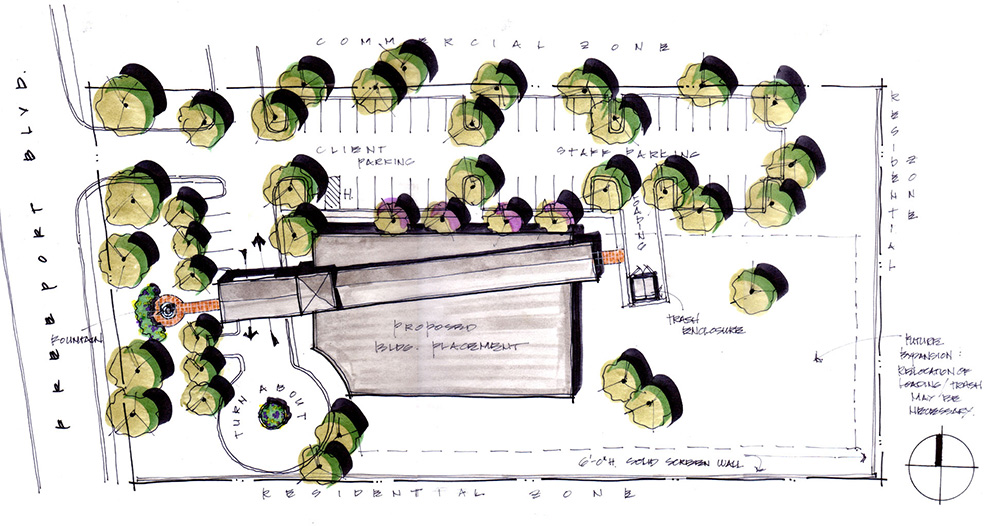Trending
Building Design for Animals
Article by Paul Gladysz, AIA, NCARB, CSI
Getting Started: Make Your Move
An array of factors goes into choosing the right location for a veterinary clinic. For starters, hire a qualified real estate agent, and then proceed.

Most projects fall into one of two types: tenant improvements to an existing building or new construction from the ground up.
Many clients who come to BDA are looking for a place to build a hospital. They might want to open their first practice, or perhaps their current clinic cannot be expanded. Unless they are experienced in the local real estate market, and very few are, our first piece of advice is to retain an experienced commercial real estate agent. Emphasis on “commercial” because if an agent isn’t familiar with available commercial land, the relevant laws and regulations, and the needs of a business, a practice owner might choose an unusable location.
The location search cannot begin until you know how much space you need. Programming, or project definition, is a necessary first step. At BDA, to produce a comprehensive program document we look at the veterinary services provided now and possibly in the future, the caseload, the clinic’s growth history, the demographics, and the budget and schedule.
Most projects fall into one of two types: tenant improvements to an existing building or new construction from the ground up. Let’s cover the basics of both.
Geographic Setting
Everyone has heard that the three most important things in real estate are location, location and location. I’d amend that to a “location that works.” What should you look for?
With an existing practice, consider:
1. Distance from your current practice. The key to a successful relocation is holding on to your clients. Ideally, your new spot will be only blocks away.
2. Visibility. You must be seen. To maintain growth, your practice needs to attract new clients.
3. Ease of access. All veterinary practices need a location that clients can enter and exit easily.
With a new practice, look at:
1. Distance from the competition. Start-up practices need to be aware of where the competition is. A new general practice wants to be the first and only one in a new planned community.
2. Visibility. An attractive, visible location is a great marketing tool.
3. Ease of access. As with any business site, getting in and out without becoming frustrated is key.
General Factors
General factors to consider:
1. Cost. Knowing how large a mortgage you can afford is the first step in creating a budget that covers site acquisition, build-out, equipment, soft costs and a contingency fund.
2. Zoning. Zoning can make or break a location. You want to be in a zone where your practice profile is allowed and no special approvals are needed.
3. Restrictive covenants. Some tenant spaces or buildings have deed restrictions.
4. Public utilities. Of course, your hospital needs electricity, water and other utility connections. Before you commit yourself, find out about water, sewer and power service sizes.
Project Type
Renovation or Tenant Improvement
Consider these important points when you look at a strip shopping center or business park:
1. Visibility. Avoid spots that have reduced frontage and limited parking.
2. Signage. Get a prime spot on the property’s main sign along the road. These signs are visible from greater distances.
3. Shape of the space. The ideal space is a square or rectangle with an aspect ratio of 1.5-to-1 (depth to width). Even a ratio of up to 2-to-1 is workable, but anything beyond that will result in an inefficient plan.
4. Open plan or load-bearing obstructions. Your clinic should be free from as many internal obstructions as possible.
5. Single floor or multistory. Multistory is bad. You want to have most, if not all, clinical spaces on the same level.
6. Pet access. Any hospital treating dogs needs a place for them to eliminate.
7. Neighbors. Dogs bark. You know it and your clients know it, but the insurance agent next door or the cranky guy living in the house behind the strip center will notice.
New Construction
Many of the points above apply to new builds, too, but other issues come into play when you search for a place to construct a hospital from the ground up.
1. Parcel size. Project programming should identify not only your current needs but also a reasonable growth projection.
2. Buildable area. You need the right size buildable area when you subtract things like large setbacks, utility and access easements, watercourse setbacks, wetlands and the like.
3. Landscape requirements. The zoning code usually addresses required green space.
4. Parking. A veterinary clinic commonly needs one parking space for every 200 to 400 square feet of building size, but your practice might need more.
5. Grading and drainage. Not all sites are created equal, and some can be costly to develop. In general, a flat site raised a few feet above the road elevation will be less expensive than a sloped site or one below street level.
This article was published in Today’s Veterinary Business.

